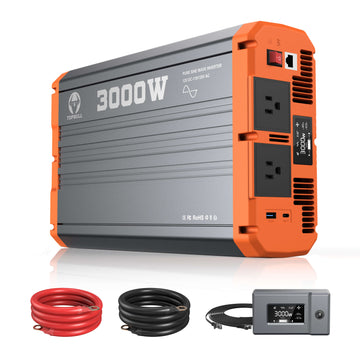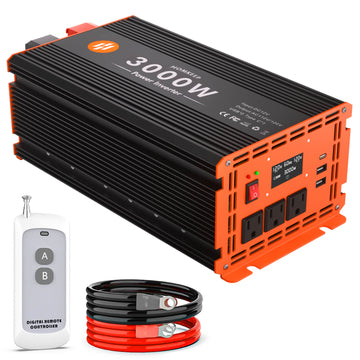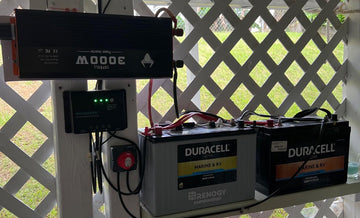Batteries, a core component of energy technology, are diverse and each type of battery typically has unique voltage characteristics. The fact that most batteries have different voltages makes battery voltage one of the key parameters for measuring battery performance and adapting it to the needs of a device. An in-depth understanding of the basic concepts of battery voltage and its importance is essential to the more efficient use of this energy technology.
Table of contents:
- The basic concept of battery voltage
- Battery Voltage History
- Why is voltage so important?
- Difference between voltage and current
- How to Measure Battery Voltage
- Nominal Battery Voltage
- Battery Discharge and Voltage
- Lead Acid vs Lithium Ion Battery Voltage
- Cut-Off Voltage
- Factors affecting battery voltage
- The relationship between battery voltage and battery performance
- Is battery voltage dangerous?
- Battery Voltage Management and Safety Measures
- What happens if a device is connected to the wrong voltage?
- Summary
The basic concept of battery voltage
Battery voltage is the potential difference between the positive and negative terminals of a battery in an open circuit (i.e., not connected to the load) or a closed circuit (i.e., connected to the load). It is an important physical measure of the battery's ability to store and release electrical energy, usually expressed in volts (V).
Batteries convert chemical energy into electrical energy through a chemical reaction. The basic principle is that a chemical reaction occurs between the electrolyte and the electrodes inside the battery, resulting in the flow of electrons from the negative electrode to the positive electrode, creating an electric current. This flow of current creates a potential difference, or battery voltage.
Battery Voltage History
The volt, the unit used to measure electrical potential, was named in tribute to Alessandro Volta, a pioneering physicist who is credited with the invention of the first electrochemical cell in 1800. This groundbreaking cell comprised a zinc electrode and a copper electrode, both submerged in an electrolytic solution made of salt and water. Additionally, Volta contributed to the popularization of the electrophone, a device capable of generating significant amounts of static electricity, although he did not invent it himself and is sometimes mistakenly credited as its creator. In recognition of his contributions, Napoleon Bonaparte awarded Volta the title of count in 1810. Furthermore, in 1881, the international system of units (SI) honored Volta by naming one of its electrical units, the volt, after him.

Why is voltage so important?
Battery voltage is important in several ways. Firstly, it is a key factor in ensuring the proper functioning of electronic devices, as different devices have different voltage requirements, and a voltage mismatch may result in reduced performance or damage to the device. Secondly, battery voltage directly affects the magnitude of the current and the power received by the device, thus affecting the efficiency of energy transfer. In addition, battery voltage is also an important indicator of battery performance, which can reflect the battery's ability to store and release electrical energy as well as the stability of the discharge process. At the same time, ensuring that the battery voltage is within a safe range is critical to preventing equipment damage and safeguarding user safety. Finally, in the power system, the stability of the battery voltage is important for the stable operation of the system. Therefore, when using batteries, it is important to ensure that the battery voltage matches the demand of the equipment and to pay close attention to the changes in battery voltage.
Difference between voltage and current
Voltage and current are two basic concepts in electrical engineering that are closely related but have different definitions and characteristics. Here are the main differences between them:
Voltage
- Definition: Voltage is the potential difference between charges, indicating the potential energy per unit charge in the electric field. We can think of it as the ‘pressure’ that drives the flow of electricity.
- Unit: Volt (V).
- Properties: Voltage is static and can exist in a circuit without a current necessarily flowing. For example, a battery can have a voltage across its terminals, but if no circuit is connected, no current will flow.
- Example: The voltage of a battery is usually a fixed value, such as 1.5V or 12V.
Current
- Definition: Current is the rate of flow of charge (usually electrons) through a conductor. It can be understood as the amount of charge that passes through a given cross-section in a given time.
- Unit: Ampere (A).
- Nature: Current can only flow in the presence of voltage and a closed circuit. It is dynamic and indicates the actual transfer of electrical energy.
- Example: When a battery is connected to a circuit, the current is shown as the number of amperes flowing, e.g. 5A.
Relationships
- Ohm's Law: the relationship between voltage and current is described by Ohm's Law with the equation: V = I x R, where V is the voltage, I is the current and R is the resistance. This means that for a given resistance, the magnitude of the current is directly proportional to the voltage.
Voltage is the ‘push’ and current is the ‘flow’: voltage provides the potential for electrical energy, while current is the actual flow of electrical energy. In a circuit, voltage drives current flow, and the amount of current depends on the resistance and voltage of the circuit.
How to Measure Battery Voltage
Measuring battery voltage is a relatively simple process, here are the exact steps and some notes.
Tools needed
Digital Multimeter (DMM) or Analogue Multimeter: This is a tool that can measure voltage, current and resistance.

Measurement Steps
Prepare the multimeter
Ensure that the multimeter is in good condition, has sufficient batteries and is set to the appropriate voltage measurement setting (usually DCV), and select the appropriate range, usually 20V is sufficient for most batteries.
Disconnecting the load
If the battery is supplying power to the device, please disconnect the load first. If the load cannot be disconnected, the measurement may be affected by the current, resulting in an inaccurate reading.
Connecting the measurement probes
Use two probes:
Black probe (negative): connect to the negative (-) terminal of the battery.
Red probe (negative): connect to the positive (+) terminal of the battery.
Read the voltage
After confirming that the probes are making good contact, observe the reading displayed on the multimeter. This is the battery voltage value.
Record the reading and make sure you remove the probe after the measurement is complete.
Safe Handling
Safely remove the probe and turn the multimeter off when the measurement is complete.
Precautions
Ensure correct polarity: Always pay attention to the positive and negative polarity when connecting the probe to avoid short-circuiting or causing damage to the device.
Beware of high voltages: If the battery voltage being measured is high, make sure to use a multimeter that complies with the voltage rating.
Check regularly: Measuring the battery voltage regularly will help determine the health and service life of the battery.
Additional Tips
Take multiple measurements: Measure battery voltage several times at different times and under different conditions to get a more accurate assessment of health status.
Use a battery tester: For some special types of batteries (e.g. lithium batteries), using a professional battery tester may provide more accurate information and additional data.
Nominal Battery Voltage
The standard voltage of a battery, also known as the rated voltage, is the voltage that should be achieved when the battery works under standard specified conditions. Different types of batteries have different standard voltages, the following are the standard voltages of some common batteries:
| Battery Type | Standard Voltage (V) | Applicable Devices |
|---|---|---|
| Alkaline Battery | 1.5 | Remote controls, electronic toys, flashlights, etc. |
| Lithium Battery | 3.0 / 3.6 / 3.7 | Digital cameras, laptops, power banks, etc. |
| Nickel-Metal Hydride Battery (NiMH) | 1.2 | Digital cameras, cordless phones, rechargeable flashlights, etc. |
| Nickel-Cadmium Battery (NiCd) | 1.2 | Cordless tools, emergency lights, remote-controlled models, etc. |
| Lead-Acid Battery | 2 / 6 / 12 | Cars, motorcycles, power backup systems, UPS, etc. |
| Lithium Iron Phosphate Battery (LiFePO4) | 3.2 | Electric vehicles, solar energy storage systems, portable tools, etc. |
| Lithium Manganese Battery | 3.7 | Portable devices, e-cigarettes, medical equipment, etc. |
Description:
- Alkaline batteries: suitable for general low-power devices, providing 1.5V.
- Lithium batteries: their standard voltage is generally between 3.0V and 3.7V, widely used in high performance electronic devices.
- Nickel Metal Hydride (NiMH) and Nickel Cadmium (NiCd) batteries: usually at 1.2V, suitable for rechargeable devices.
- Lead-acid batteries: can have various voltages (2V, 6V, 12V) and are widely used in automobiles and power backups.
- Lithium Iron Phosphate (LiFePO4): Available in 3.2V, suitable for electric vehicles and high energy storage applications.
Battery Discharge and Voltage
Battery discharge is the process by which the chemical energy stored inside a battery is converted into electrical energy through a chemical reaction. During the discharge process, a potential difference is formed between the positive and negative terminals of the battery, which drives a current to flow in an external circuit.
Changes in Battery Voltage
Initial Stage:
In the initial stage of battery discharge, the voltage is higher due to the active chemical reaction inside the battery and the potential difference.
At this time, the battery is able to provide stable current and voltage output to meet the demand of the equipment.
Discharge process:
- As the discharge proceeds, the chemicals inside the battery are gradually consumed and the potential difference gradually decreases, resulting in a gradual decrease in voltage.
- The decrease in voltage is a direct reflection of the decrease in battery power.
- During the discharge process, the voltage reduction usually shows a smoother curve, but it may also fluctuate under the influence of discharge current, temperature and other factors.
End of Discharge:
- When the chemicals inside the battery are almost completely depleted, the potential difference will drop to a very low level, at which point the voltage will drop dramatically.
- When the voltage drops below a certain threshold, the battery will no longer be able to provide enough current to drive the device to work, marking the end of the discharge process.

Lead Acid vs Lithium Ion Battery Voltage
Battery voltage is not constant and fluctuates depending on the charge level of the battery. When fully charged, the battery voltage is higher than when the charge is low or depleted. This voltage variation is called voltage loss and varies by battery type. Lead-acid and lithium-ion batteries have different voltage characteristics. The following is a comparison of their voltages:
Lead-acid battery state-of-charge voltage table

LiFePO4 Lithium Battery Voltage Chart

Cut-Off Voltage
Factors affecting battery voltage
1. Battery type
2. Temperature
3. Discharge rate
4. Battery Status
5. Internal Resistance
6. Chemical reaction
Electrolyte quality: The concentration and quality of the electrolyte will affect the mobility of ions, thus affecting battery performance and voltage.
7. External Load
8. Charging Method
The relationship between battery voltage and battery performance
Battery voltage stability is critical to battery performance
The stability of the battery voltage is an important factor in measuring the performance of a battery. During the use of the battery, its voltage will fluctuate with time and use conditions. If the battery voltage is unstable, it may lead to a decrease in the performance of the device or even damage the device. Especially in high power consumption applications such as electric vehicles, voltage stability is critical to ensure the normal operation of the equipment and to extend the life of the battery.
Battery voltage is also closely related to its life. Either too high or too low a voltage can have an impact on battery life. For example, overcharging may lead to increased pressure inside the battery, which may lead to problems such as bulging and leakage; while over-discharging may lead to excessive depletion of chemicals inside the battery, resulting in a decline in battery performance. Therefore, when using a battery, you need to ensure that its voltage meets the required standards, and avoid working at too high or too low a voltage for a long period of time.
Battery voltage is also closely related to its safety. In the process of charging or discharging, if the battery voltage is abnormally high or low, it may cause short-circuit, overheating and other problems inside the battery, which may lead to battery explosion, fire and other safety accidents. Therefore, in the design and use of batteries, we need to strictly control the voltage range of the battery and take effective safety measures to ensure the safety of the battery.
Is battery voltage dangerous?
- Overheating and fire: When the voltage of a battery is abnormally high, the chemicals inside it may become unstable. For example, the electrolyte in a lithium battery may decompose under high voltage, generating gas and heat. If this is not controlled in time, the battery may expand, leak or even explode. In addition, excessive voltage may also cause damage to the diaphragm inside the battery, making the positive and negative electrodes come into direct contact, which can lead to short circuits and fires.
- Battery damage and performance degradation: Abnormal battery voltage may also lead to changes in the internal chemical structure of the battery, which can damage the performance and life of the battery. For example, overcharging may lead to increased pressure inside the battery, triggering problems such as bulging packs and leakage; while over-discharging may lead to excessive depletion of chemicals inside the battery, resulting in reduced battery performance.

Battery Voltage Management and Safety Measures
Effective management and safety measures are required to reduce the safety risks associated with abnormal battery voltage:
- Use original or certified chargers: Incompatible chargers may cause abnormal battery voltage. Therefore, it is recommended to use original or certified chargers for charging to ensure the stability and safety of the charging process.
- Regularly check the battery status: Regularly check the voltage of the battery to understand the current status of the battery. By measuring the voltage of the battery, you can determine whether the battery needs to be charged or discharged, and whether there are any abnormal conditions.
- Avoid prolonged idling of batteries: Batteries that have been idle for a long period of time may suffer a voltage drop due to self-discharge. Therefore, avoid leaving the battery idle for a long time, and charge and maintain the battery regularly.
- Pay attention to the use of the environment: the use of the battery environment will also affect its voltage stability. When using batteries, care should be taken to avoid high temperatures, humidity and other harsh environments, so as not to cause damage to the battery.
What happens if a device is connected to the wrong voltage?
When a device is inadvertently connected to the wrong voltage, a series of chain reactions can creep in, posing a serious threat to the device's performance, safety and even its overall lifespan. Imagine a sophisticated electronic device whose internal circuits and components are carefully designed based on a specific voltage range. Once plugged into a voltage that is far above or far below its design criteria, it's as if these components are placed in an unfamiliar environment and begin to experience unprecedented stress.
For starters, you may notice that the performance of the device begins to slip. Motors may not run at expected speeds and make unusual noises; laser beams may become erratic or even go out altogether; and electronic devices may experience flickering screens, automatic reboots, or fail to turn on at all. All of these are due to the wrong voltage causing the internal circuitry of the device to work abnormally and the synergy between components to break down.
Immediately after this, safety issues begin to surface. Excessive voltage can lead to excessive heat being generated inside the device, triggering a significant increase in the risk of fire or electric shock. Particularly in devices that require high voltage drive, such as welding machines, incorrect voltage access can lead directly to electrocution of the operator, with irreversible consequences. And even if the equipment survives the wrong voltage, damage to its internals may lead to frequent failures in future use, increasing maintenance costs and downtime.
In addition, the wrong voltage may accelerate the aging process of the device. Batteries may quickly run out of life at the wrong charging voltage, while other electronic components may fail prematurely due to overheating or overloading. This means that even if the device still looks intact on the surface, its insides may be riddled with holes and ready to collapse.
For this reason, proper voltage access is crucial for any electronic device. Always double-check the nameplate and power requirements of your device before connecting it to a power source to ensure that the correct voltage level is selected. It is also essential to use the right power cord and plug. Only in this way can we ensure that the equipment operates in the best possible condition, prolonging its service life while safeguarding the personal safety of the operators.
Summary
Battery voltage is a key factor in battery performance and safety. Understanding the basic concepts, measurement methods of battery voltage is crucial for the safe and effective use of batteries. By scientifically managing battery voltage, we can fully utilise the energy potential of the battery and ensure the reliability and safety of our equipment.













